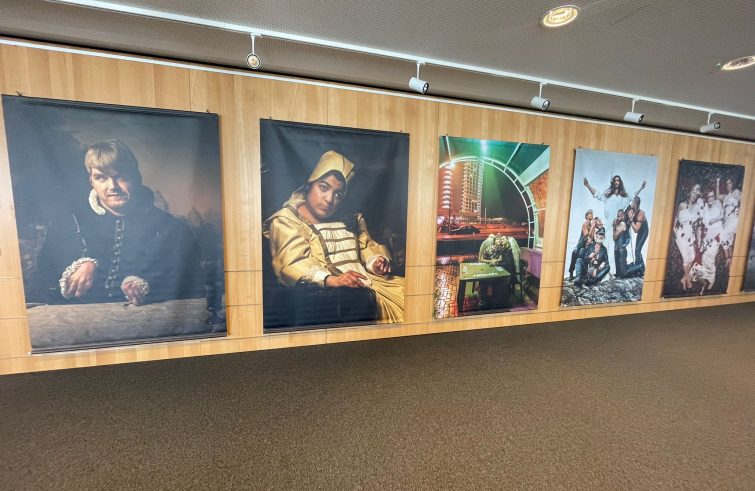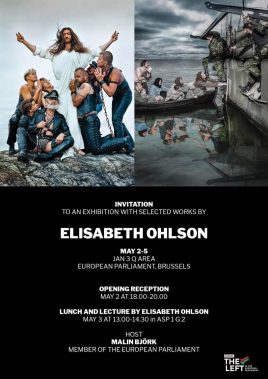
“Welcome to the opening reception with Elisabeth Ohlson. Drinks and snacks will be served.” A message with a somewhat appealing prospect of enjoying an aperitif. Thus, at 6 p.m. this afternoon, an exhibition featuring the works of Swedish photographic artist Elisabeth Ohlson will open on the third floor of the European Parliament building in Brussels, in the Jan 3 Q area, located right next to the hall named after Alcide De Gasperi. Invited guests include MEPs, parliamentary aides, officers and journalists whose activities revolve around the Eurochamber.
 Swedish MEP Malin Bjork sent out the invitations: “Dear all – she wrote in an email Urbi et Orbi – on the occasion of the Swedish European Council Presidency, we have invited photographic artist Elisabeth Ohlson to display some of her works. All the pictures she has chosen for this event have a LGBT or otherwise inclusive human rights theme.”
Swedish MEP Malin Bjork sent out the invitations: “Dear all – she wrote in an email Urbi et Orbi – on the occasion of the Swedish European Council Presidency, we have invited photographic artist Elisabeth Ohlson to display some of her works. All the pictures she has chosen for this event have a LGBT or otherwise inclusive human rights theme.”
The message comes with two images. One depicting a small migrant vessel with a foot that pushes it away from a ship (refusing rescue at sea?), and the other depicting a long-haired male figure wearing a white tunic, allegedly evoking Jesus, surrounded by men in ‘sadomasochistic’ attire (this is how it is explained- with a furrowed brow – in the corridors of the European Parliament by those in the know).
It is clearly supposed to be an artistic provocation. A way of drawing attention, once again, to forms of discrimination against homosexuals.
For further clarification – should someone fail to understand the deep meaning of the works – there will be a press conference with Ohlson scheduled for tomorrow, at noon.
Needless to say, the works have already been lambasted as scandalous by some. Others branded them as blasphemous. While e-mails are being exchanged in Parliament for and against the exhibit (and who knows whether among the politicians who are comprehensibly hurt, there are those who find it hard to welcome migrants, and see them as nothing more than a dangerous emergency… but that’s beside the point …)
Moreover, there are some facts that give rise to an equal number of questions. First of all, where are we to find the intelligent, utterly expressive newness (which perhaps should characterise every work of art) in a ‘rainbow’ Christ accompanied by a group of bikers wearing studded black leather outfits? This is no different from the past exhibition ‘Ecce Homo’ by the same artist, where the Gospel’s Last Supper saw the Lord surrounded by gay and transgender characters.
If the figure of Jesus is deemed ‘useful’ for a pro-Lgbtqi campaign, why not reflect on whether such a depiction might hurt the sensitivities (indeed, the rights!) of a significant share of that part of humanity
that believes in Jesus Christ, the Son of God made man, who died and rose from the dead for the salvation of mankind? It would appear that at the “democracy and freedom house”, some are “more equal than others””- as George Orwell put it in his “Animal Farm” – such that they are entitled to offend a religious faith and those who profess it. In one of the e-mails exchanged across the Parliament building these past few hours, someone wrote: “Have you ever heard the phrase: stop making stupid people famous?”. Perhaps the emphasis placed on this story gives good publicity to the artist herself, whose notoriety will definitely add to the value of her works. It could therefore be argued that even this article contributes to giving further visibility to the Swedish photographer.
But one more question remains. To ensure the due, even necessary, respect for LGBT people, politics, norms, culture, and education providers must play their part. However, the same level of respect should be accorded to those who, confronted with certain provocations, could feel that their values and beliefs have been trampled upon. There ensues that a common modus operandi should govern every battle in defence of human life and dignity.
Moreover, the picture at issue can certainly be criticised for repeating familiar patterns, depictions that are already old hats, evidence that has been tried and tested many times.
One might call it a truism. Nevertheless, growing accustomed to the rule of platitude is perhaps the greatest flaw in Elisabeth Ohlson’s work. That truism which, if embraced unabated, is likely to cease challenging our minds, resulting in a downfall that makes repetitive laziness a pointless nonsense. If platitude takes over art, the latter risks being subdued by nothingness.
“Christ crucified, a stumbling block to Jews and folly to Gentiles”, wrote St Paul over 2000 years ago addressing the community of Corinth. Hence should anyone consider ‘using’ Jesus to cause disquiet or stir consciences, they need only reread the Gospel. Therein lies the true scandal, the different and alternative thought, proclaimed, then as today, in full respect of the prevailing, contemporary thought.











